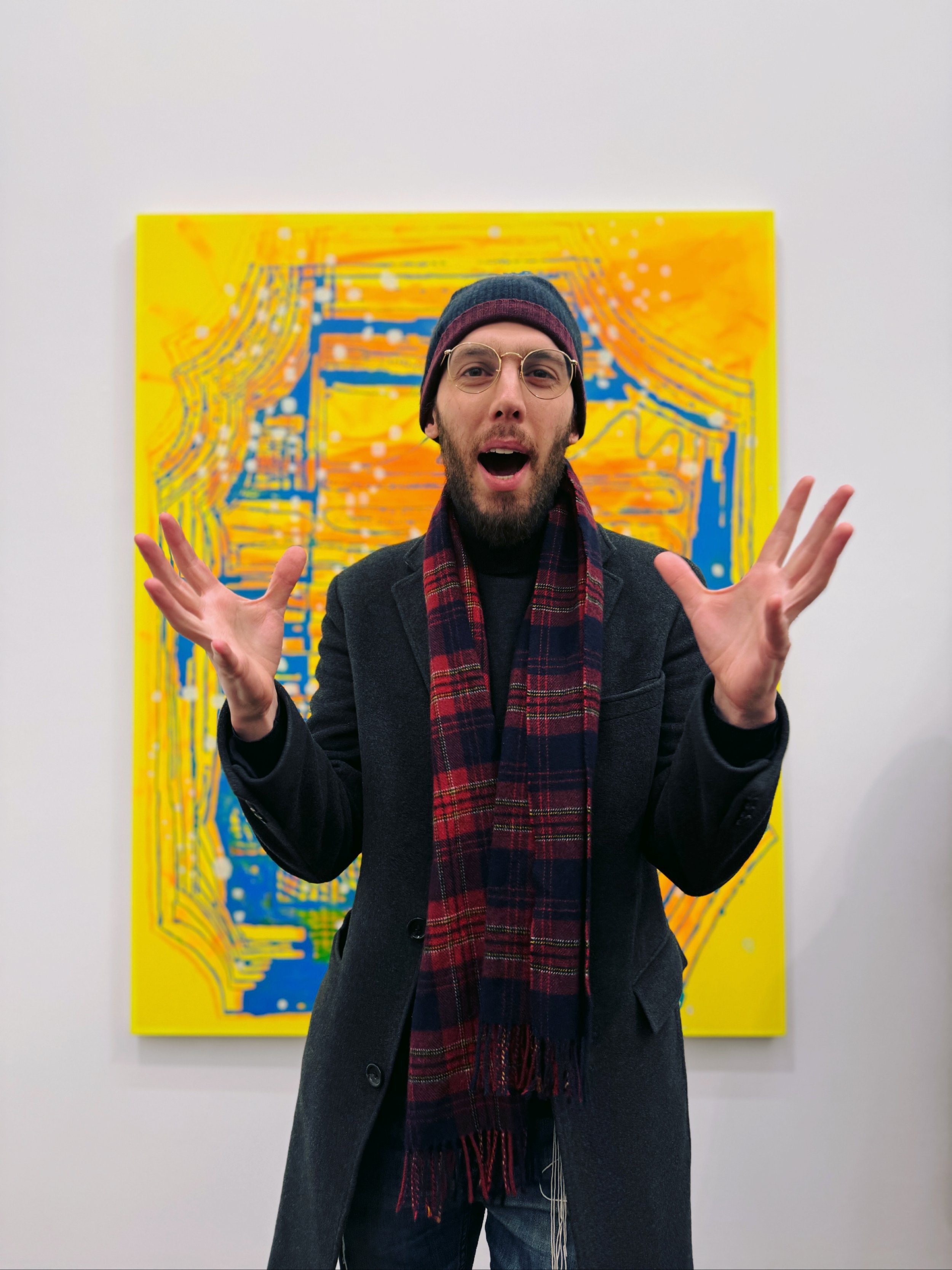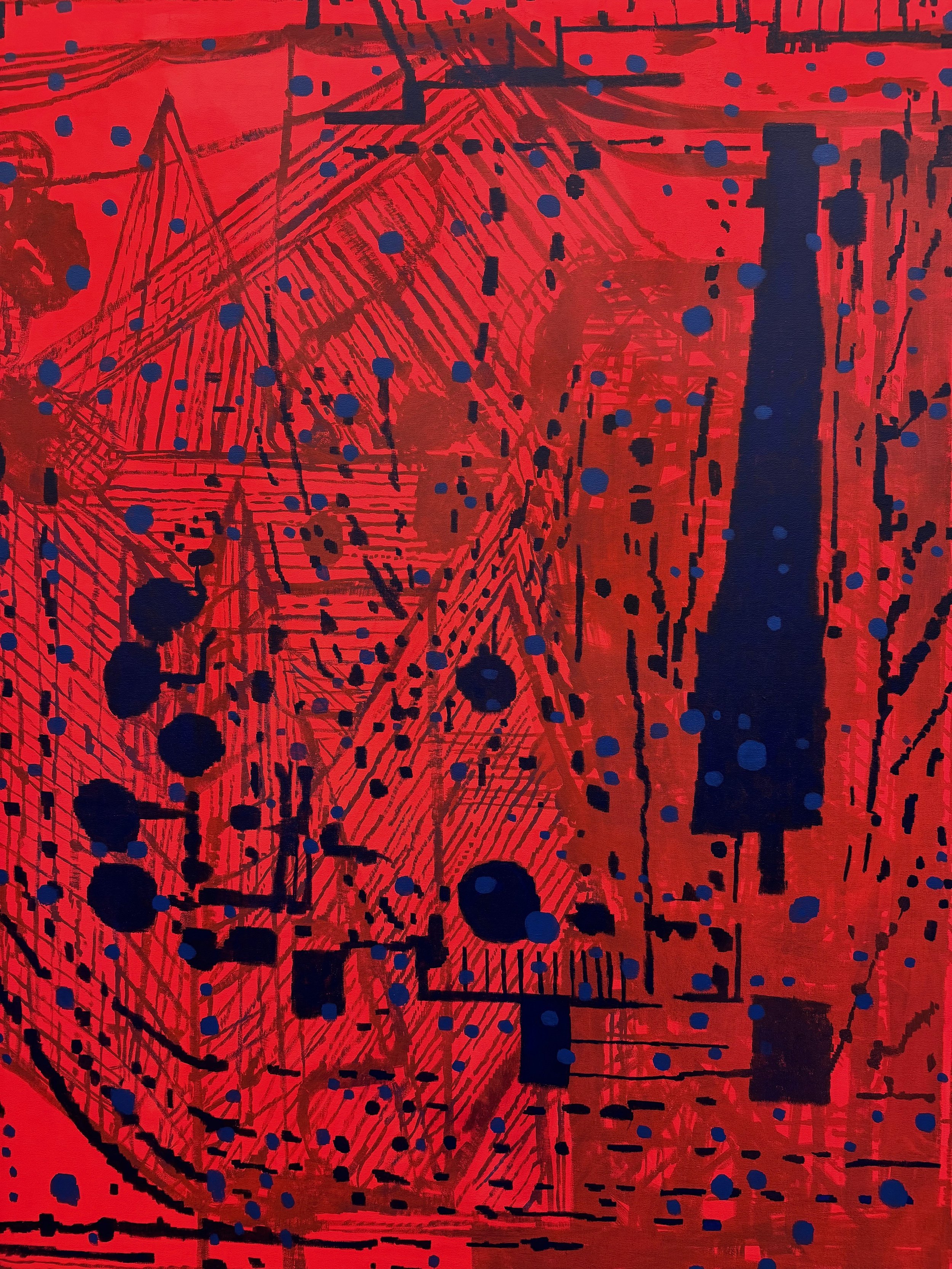Samuel Abelow pictured in front of a EJ Hauser painting, presented by Derek Eller Gallery. Photograph by Kendra Terry.
Kendra Terry. Brooklyn, NY.
Johannes Böckmann. Leipzig, Germany
By Samuel Abelow, Kendra Terry, Johannes Böckmann
Life is filled with feeling, for me. A feeling that there is a certain significance to events, that they are connected to meaning. Many call this synchronicity. Jewish mystics call this hashgacha pratit – divine oversight. It is this perception of life that I want to show you, in a re-telling of the first week of February, in New York City.
Lower East Side. It’s warm enough to be March, but it’s soon Valentine's Day. Outside of Derek Eller Gallery, which appears like a luminescent ice cube among the gritty surroundings, is my colleague Kendra Terry, author and training psychoanalyst.
We enter the gallery which is teaming with an eccentric, yet earthy crowd of artsy, somewhat older people: everyone is there for EJ Hauser’s solo exhibit, “The Grow Room”. Kendra remarks that the crowd, adorned in thick-framed oversized glasses, looks equally like it could be a group of artists or psychoanalysts. I think I will speak to the gallerist, Derek Eller. Where is he? Kendra and I pause at each canvas and converse.
Snapshots of EJ Hauser paintings, as installed at Derek Eller. Photographed by Samuel Abelow.
Abstract? Art?
“What do you think makes these paintings art?” asks Kendra.
I inspect the meticulous layers and sophisticated use of color: “The discipline and commitment to a particular mode and approach in a serious way, makes EJ’s works art.” I pause, “The paintings seem rather buyable to me. There’s a decorative value to them. I could imagine a young live streamer with expendable income putting that lime green one on the wall.”
Another pause. I add, “There's also the effort and intention involved. One person makes a doodle on the back of their homework, another invests a year investigating doodles on large format canvases and puts it in a gallery for commercial sale. Is not the intention and follow through relevant to what defines art?”
“I still get stuck on the question,” responds Kendra, “On whether art must have some aesthetic component. Very 19th century, but I still want it to be beautiful, in one way or another. It should evoke conversations, challenge ideas, or add new perspectives.”
We discuss for some time the peculiar motifs in EJ’s paintings: tree shapes, lines and circles; abstract formulas that repeat themselves across the accomplished set of about a dozen canvases.
Kendra looks from afar at a large lime green canvas. Then an association to Kendra’s work experiences comes to mind and she says, “When a patient looks at a Rorschach card and only sees color, it is an indication of psychotic thinking.
“Really?!”
“Yes, the mind is fluid,” Kendra says, “Without structure. We call it a ‘color response’ instead of a ‘form response.’ Form responses are more common.
“Every visual artist has to narrow their expression in some manner in order to excel.” I say, “EJ has chosen to focus on color. We can’t analyze the artist’s psyche, but we can see that the choice to avoid obvious thematic content (imagery), makes the works focus more readily on the material itself: color & light. There’s an advantage to that.”
(I then bring the conversation back to myself, somehow, as artists are so efficient at doing.) “As opposed to my own works, which are difficult.”
✾ ✾ ✾
Later that evening, I elaborate on this thought in a voice memo to my colleague Johannes, a training Protestant Theologian and art collector in Germany: “My works deal with gender, ethnicity, religion, mysticism and esoteric ideas, as well as my own personal identity and psychology. Could it be more difficult and challenging?!”
Johannes voice memos back: “Maybe it’s not so much about difficulty, but ponderability.”
“You’re tapping into a debate here that can only exist in our weird times: outer form (beauty) and ideas to be pinned against each other. Which is the cause of which? Spiritus or materia? Form or idea? Which is primary? Absurd! In ancient philosophies, form and ideas are inextricably linked.”
“I think, it’s a Modern misunderstanding of reality, to split form and idea; there’s an innate congruence between form and idea, especially in art! And there is a way to heal this split: to – as you put it – seek out intention. Outer materiality, the freedom and inner necessity of the artist, the expression that he wants to make – all of these qualities align in intention; that’s how you find real art.”
Samuel Abelow pictured in front of a EJ Hauser painting, presented by Derek Eller Gallery. Second snap, photograph by Kendra Terry.
Now that Johannes has once and for all defined real art, I feel settled on the question.
Johannes: “I do tend to pontificate.”
Worthwhile pontifications, but what about this world?
✾ ✾ ✾
I began with defining my certain sense of synchronicity, of divine purpose to life. But this isn’t a naive way of seeing the world. Rather, this is a subtle noticing of how events unfold and what it might lead to next. I connect this to creativity: letting go of control and allowing engaging with the natural unfoldment of self-organizing infinity.
It is this mode of relating to reality and the larger implications of a life of meaning that we will continue to convey in this essay series.
End of Part One. Subscribe to read Parts Two & Three







